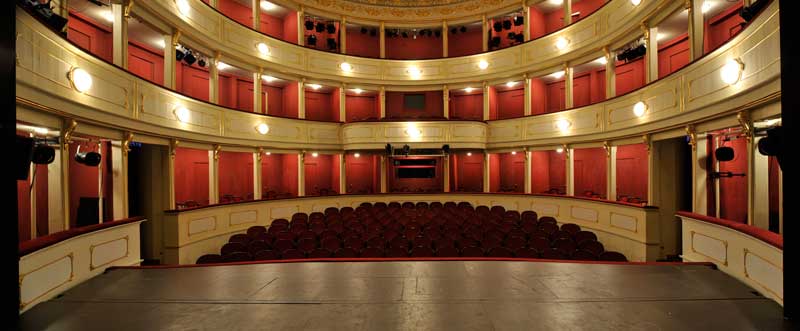 Slovene National Theatre
Slovene National Theatre
The Slovene National Theatre Maribor is the largest cultural institution in Slovenia and the only repertory theatre that unites drama, opera, ballet and symphony orchestra. Every season, it offers about 500 performances of 30 different productions to more than 200,000 theatre-goers. The SNG's Old Hall was the first permanent theatre in Maribor. It opened in 1852 as German Municipal Theatre, as Maribor was a bilingual town. In 1919, it became the Slovene National Theatre. A modern New Hall was attached to the historic building in 1994. The last restoration of the Old Hall was completed in 2003.
Each year in October, the theatre hosts Maribor Theatre Festival, presenting productions from Slovenia and abroad.
Slovensko narodno gledališče · Slovenska 27 · 2000 Maribor · Slovenia
Tel. box office: +386 2 25 06 115 · Fax: +386 2 25 06 210 · boxoffice@sng-mb.si · www.sng-mb.si
Visits: on appointment
Tourist office - TIC Maribor
Tel.: +386 2 23 46 611
tic@maribor.si
www.maribor-pohorje.si
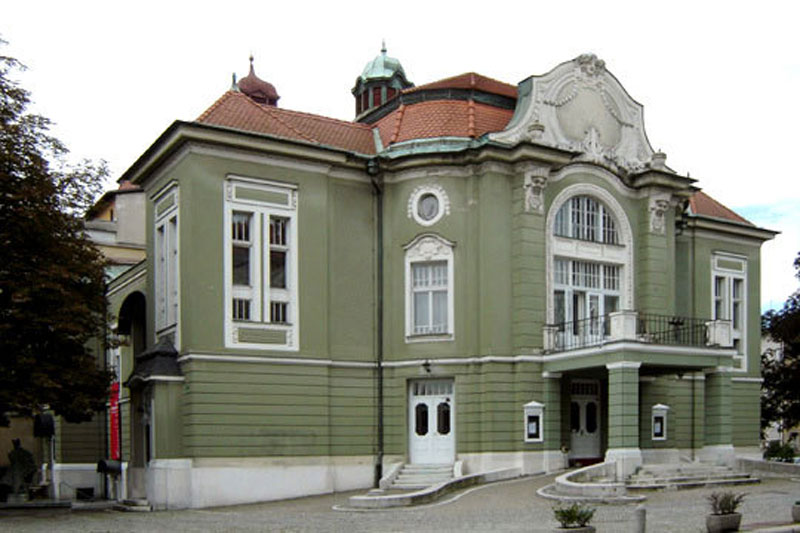 SNT Drama
SNT Drama
In Ljubljana, part of the Habsburg Empire from 1278 to 1918, the Slovene population and the Austrian population used to have one theatre where performances were given in Slovenian and German. As the national feelings grew stronger in the late 19th century, the ruling minority commissioned its own theatre building, which opened in 1911 as "Emperor Franz Joseph Jubilee Theatre", commemorating the 60th anniversary of the Austrian monarch's coronation. The Viennese architect Alexander Graf, former collaborator of Fellner & Helmer architects, mixed neo-baroque and Secessionist style, thereby creating something conservative with a then modern touch. In 1919, it became the Slovene National Theatre – Drama. Extensions were attached to the building in the 1960s and the auditorium slightly modified. Also worth seeing is the former Provincial Theatre (1892), since 1919 the SNT Opera and Ballet.
Slovensko narodno gledališče Drama Ljubljana · Erjavčeva 1 · 1000 Ljubljana · Slovenia
Tel.: +386 1 252 14 62 · Fax: +386 1 252 38 85 · E-mail: info@drama.si · www.drama.si
Visits: on appointment
Tourist information – STIC
Tel.: +386 1 306 45-75 / 76
stic@visitljubljana.si
www.visitljubljana.com
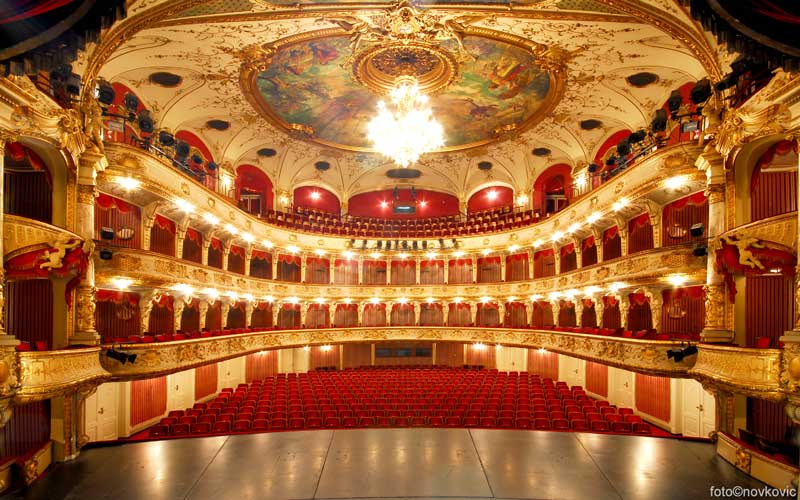 Croatian National Theatre
Croatian National Theatre
On 14 October, 1895, the Austrian Emperor Franz Joseph I himself opened this theatre, a wonderful building by the Viennese architects Fellner & Helmer. Busts of important Croatian poets and a composer guard the exterior. The Viennese painter Alexander Demetrius Goltz created the paintings on the ceiling of the auditorium, whereas the ceiling of the foyer was decorated later by Ivan Tisov, in 1911.The impressive curtain from 1895, named "The Reformation of of Croatian Literature and Art", is by the painter Vlaho Bukovac. In the 120 years of its existence, the theatre underwent only two technical and structural renovations. Thus, apart from the now modern stage, the building has been entirely preserved. The CNT offers opera, drama and ballet performances almost every day.
Hrvatsko Narodna Kazalište · Trg maršala Tita 15 · 1000 Zagreb · Croatia
Tel: +385 1 48 88 488 · Fax: +385 1 48 88 402 · E-mail: hnk@hnk.hr · www.hnk.hr
Visits: on appointment
Tourist Information Centre
Tel.: +385 1 48 14-051/ 052 / 054
info@zagreb-touristinfo.hr
www.zagreb-touristinfo.hr
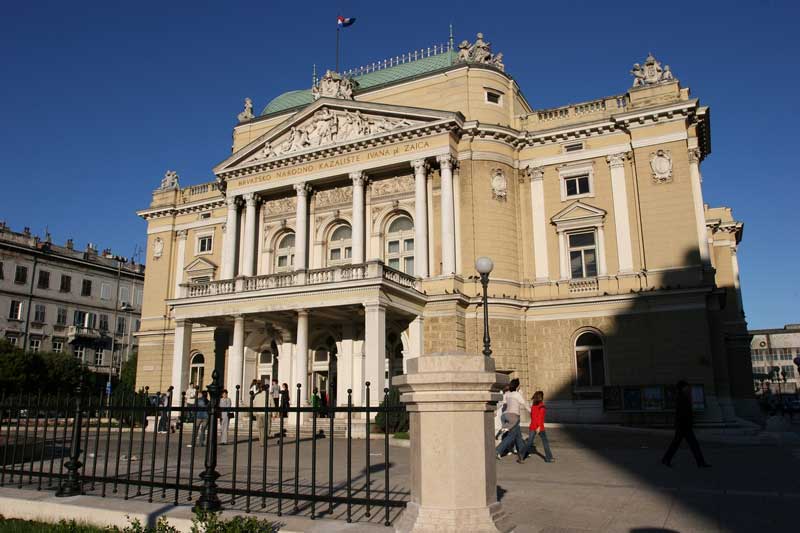 Croatian National Theatre "Ivan pl. Zajc"
Croatian National Theatre "Ivan pl. Zajc"
This impressive building was designed by the famous Viennese architects Fellner & Helmer and opened on October 3, 1885, as "Teatro Comunale" with Verdi's "Aida". Neo-renaissance on the outside and neo-baroque inside, it also features a painted ceiling by Gustav and Ernst Klimt and Franz Matsch, as well as noteworthy statutes by the Venetian sculptor Augusto Benvenuti. The theatre was named after Giuseppe Verdi in 1913, but after becoming a Croatian National Theatre in 1945, Verdi was replaced by the most important Croatian composer, Ivan Zajc (1832 – 1914). Notwithstanding this, it is home today for a Croatian drama ensemble and an Italian drama ensemble, as well as an opera company and a ballet troupe, entertaining more than 100,000 spectators every year.
Hrvatsko Narodno Kazalište Ivana pl. Zajca · Uljarska 1 · 51 000 Rijeka · Croatia
Tel: +385 51 3559-24/17 · Tel. box office: +385 51 337 114 · E-mail: zajc@hnk-zajc.hr · www.hnk-zajc.hr
Visits: on appointment
Tourist office
Tel.: +385 51 315 710
Rijeka@visitrijeka.hr
www.visitrijeka.eu
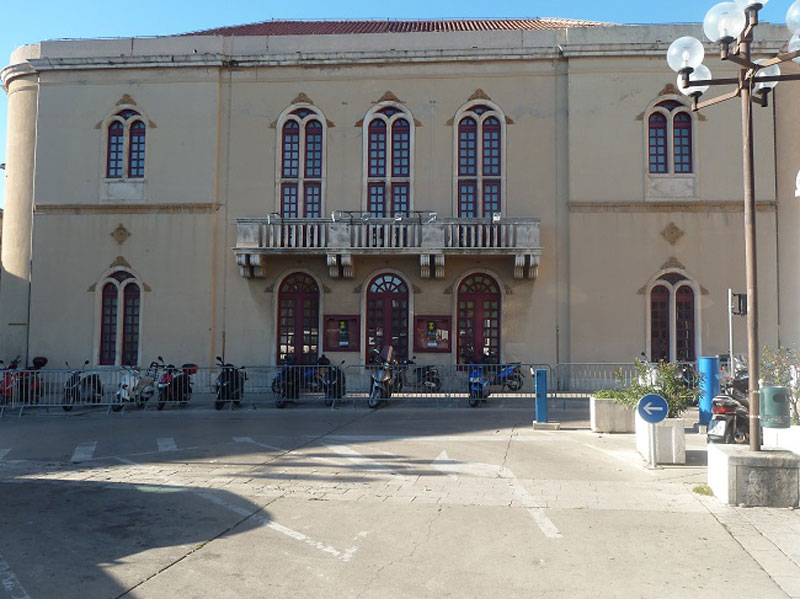 Croatian National Theatre
Croatian National Theatre
Josip Slade, who later also designed the Zetski Dom theatre in Montenegro, has given this theatre a very special look: the facade suggests medieval times, which is very unusual for a theatre, with allusions to the Gothic style, combined with Romanic elements. Whereas inside, the architect took the Teatro Fenice in Venice as a model for the auditorium. In short: this is a fine example of the 19th century eclectic style. The painted ceiling by Antun Zuccara portraits those citizens of Šibenik who financed the theatre construction. The theatre was inaugurated in 1870 and restored 1996–2001, after having suffered war damages in 1991. The Šibenik theatre has its own repertory company and also presents guesting performances.
Hrvatsko Narodno Kazalište u Šibeniku · Kralja Zvonimira 1 · 22 000 Šibenik · Croatia
Tel.: +385 22 213 123 · direkcija@hnksi.hr · www.hnksi.hr
Visits: on appointment
Tourist Information Centre
Tel.: +385 22 214-448 / 411
E- mail: tz-sibenik@si.t-com.hr
www.sibenik-tourism.hr
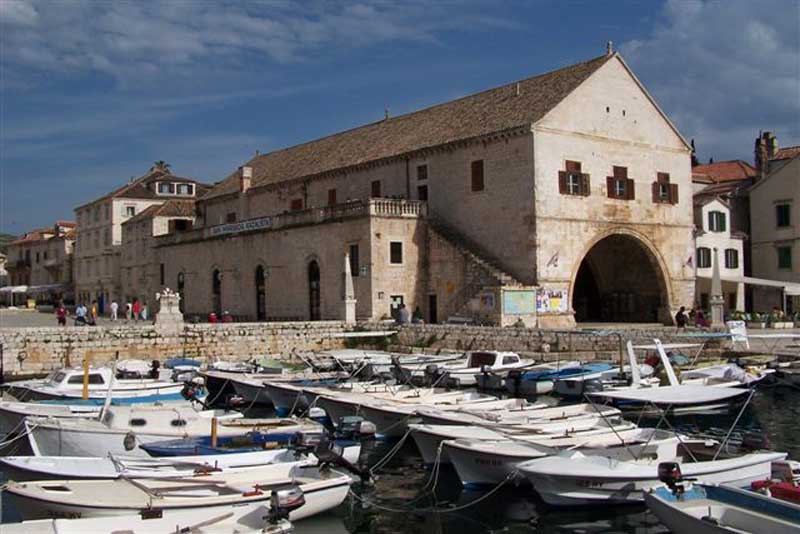 Theatre in the Arsenal
Theatre in the Arsenal
Between 1278 and 1797, Hvar was part of the Republic of Venice and a winter port for its fleet. In 1612, the Venetian govenor of the island, Pietro Semitecolo, had the theatre built on the first floor of the impressive Arsenal. Though much changed in the course of time, it remains the oldest communal theatre space in Europe. The present version was created in 1803, making it the oldest theatre in Croatia today. It features a tiny, Italian opera house style auditorium with two rows of boxes. Throughout its 400 years of existence, the theatre has presented quality performances of the local amateur theatre groups, a tradition that is alive today. The Arsenal and the theatre are classed as monument of national importance. The theatre is presently being restored, but can be visited on appointment.
Hvarsko kazalište · Trg Svetog Stjepana · 21 450 Hvar · Croatia
Administration: Hvar Heritage Museum · Hanibala Lucica b.b. · 21 450 Hvar · Croatia
Tel: +385 (0)21 741 009 · E-mail: Muzej.hvarske.bastine€gmail.com · http://mhb.mdc.hr
Visits: on appointment
Tourist office
Tel.: +385 (0)21 741 059
info[at]tzhvar.hr
www.tzhvar.hr/en/
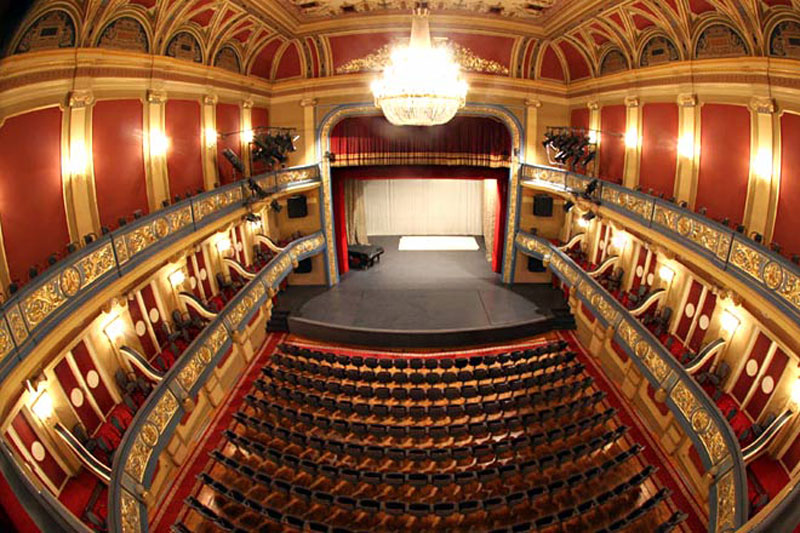 National Theatre
National Theatre
This theatre building started its life in 1899 as a community centre for the Austrian ruling class, designed by Karla Paržik and including a multipurpose hall. For this reason, the auditorium looks more like a concert hall. But already for the inauguration, drama was offered: "Medea" by the Austrian classic Franz Grillparzer, in a guest performance by the theatre from Zagreb. The impressive facade with five entrances and the noble decoration of the auditorium testify to the wealth of the city around 1900. In 1921 the building became home of the National Theatre that had been founded only two years before, the first professional theatre company in Bosnia and Herzegovina. In 1946, the opera and ballet company joined the drama ensemble. The three ensembles perform from October to June.
Narodno pozorište Sarajevo · Obala Kulina bana 9 · 71 000 Sarajevo · Bosnia & Hercegovina
Tel. box office: +387 33 221 682 · Tel. marketing: +387 33 665 963 · E-mail: marketing@nps.ba · http://nps.ba
Visits: on appointment
Tourist information
Tel.: +387 58 09 99
tourinfo@bih.net.ba
www.sarajewo-tourism.com
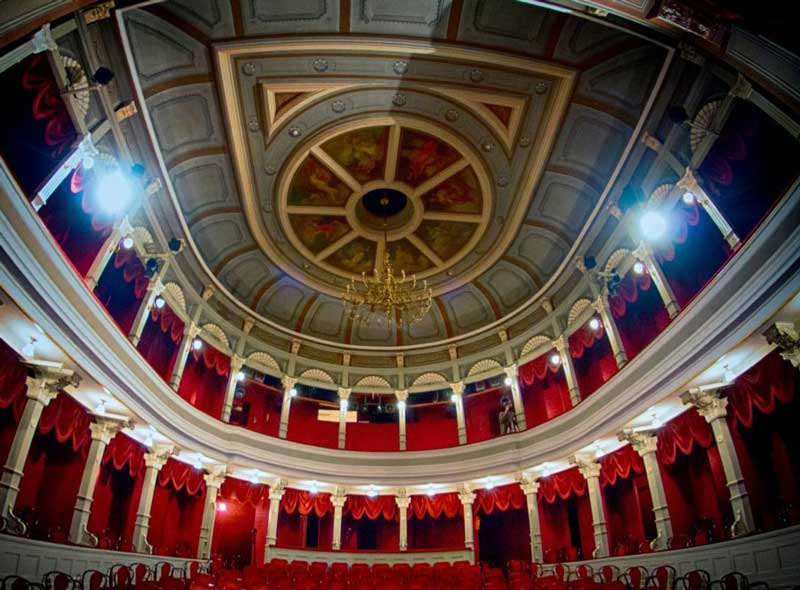 National Theatre
National Theatre
Sombor was part of the Austrian Empire from 1687 to 1918. It became a Free and Royal City in 1749, the capital of the region. The city was trilingual, with Serbian, Hungarian and German as equal languages. Here, the writer Jovan Đorđević (1826-1900) founded the Serbian Theatre Association in March 1850, before he went on to found the Serbian National Theatre in Novi Sad and National Theatre in Belgrade. His activities created the need for a theatre building in Sombor, and Adolf Vajt was chosen as the architect. The theatre opened in 1882, presenting itself in neoclassical style with some modern additions. Austrian, Hungarian and Serbian companies presented their productions, and in 1946 the first permanent ensemble was established. For its 100th anniversary, the building was given a careful renovation. Today, it is one of the most important theatres in Serbia.
Narodno pozorište · Trg Koste Trifkovića 2 · 25000 Sombor · Serbia
Tel.: +381 25 414 966 · Tel. box office: +381 25 436 373 · E-mail: nps.sekretar@sbb.rs · www.npozoristeso.co.rs
Visits: on appointment
Sombor Visitors Board
+381 25 434 350
info@visitsombor.org
www.visitsombor.org
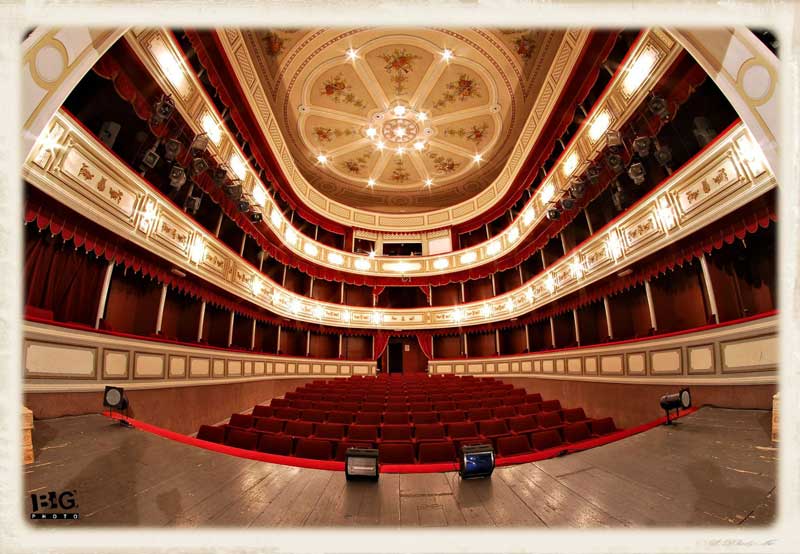 National Theatre "Toša Jovanović"
National Theatre "Toša Jovanović"
The city of Zrenjanin received its present name in 1946, having been known as Bečkerek for most of the preceding times, testifying to its Hungarian origins in the 14th century. The city rose from the ashes of a great fire in 1807, and in the 1830s, a granary was transformed into a theatre - the oldest theatre in Serbia. Its present appearance dates from 1884, brought back in 1985 by a thorough restoration campaign. Here touring companies from Hungary, Austria and Serbia entertained the citizens, before it got its own troupe of actors and became a National Theatre in 1946. Since 1978, it has also been home to one of the world's best puppet theatre companies. The theatre is named after the Romantic actor Toša Jovanović (1845-1893) who was born in Bečkerek.
Narodno pozorište "Toša Jovanović" · Trg Slobode 7 · 23000 Zrenjanin · Serbia
Tel./Fax: +381 23 560 141 · Tel. box office: +381 23 560 136 ·
E-mail: pozoriste.tosajovanovic@gmail.com · www.tosajovanovic.org.rs
Visits: on appointment
Tourist Information Centre
Tel.: +381 23 581 890
office@zrenjanintourism.org
www.zrenjanintourism.org
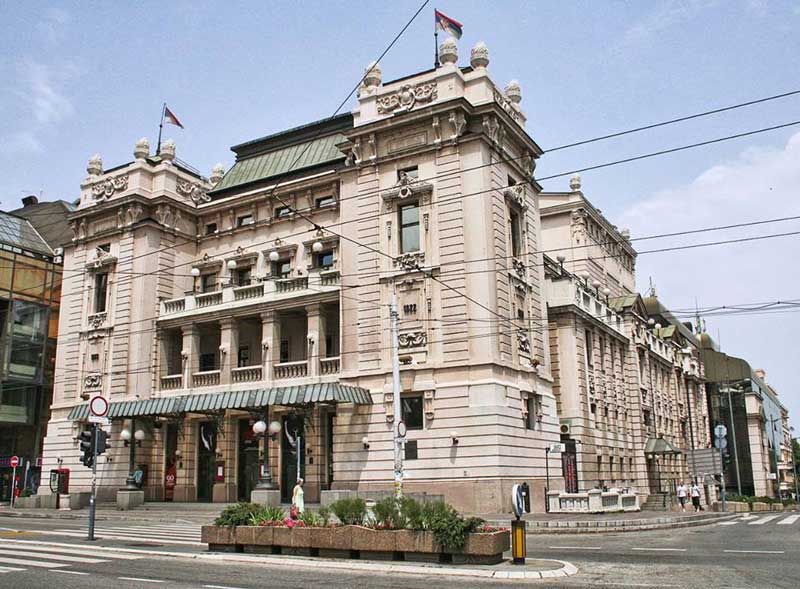 National Theatre
National Theatre
The National Theatre in Belgrade, an Institution of National Importance, was opened on October 30, 1869, in the Serbian capital Belgrade, commissioned by Mihailo Obrenović III, Prince of Serbia, and designed by one of the most important Serbian architect, Aleksandar Bugarski, who took the Scala in Milan as a model. Between 1919 and 1922, the building was remodelled and enlarged. Architect Josif Bukavac accentuated the main façade, now in neo-baroque style, with the two corner towers that conceal staircases. After devastations in WW II, the theatre was reconstructed in 1964/65, but the stage and facade remained unchanged. Final reconstruction was made 1986-1989. It was proclaimed a Cultural monument of great value in1983. There are performances of Drama, Ballet and Opera.
Narodno pozorište u Beogradu · Francuska 3 · 11 000 Beograd · Serbia
Tel: +381 11 328 133 3 · Fax: +381 11 262 256 0 ·
E-mail: istrazivackicentar@narodnopozoriste.rs - www.narodnopozoriste.rs
Visits: on appointment
Tourist Office City center
Tel.: +381 11 26 35 - 622/343
bginfo.knezmihailova@tob.co.rs
www.travel-belgrade.com
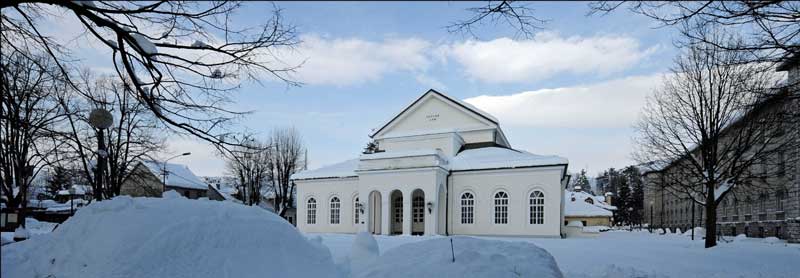 Royal Theatre Zetski Dom
Royal Theatre Zetski Dom
Cetinje was the capital of Montenegro from the late 15th century to the end of World War II. When the country finally freed itself from the Ottoman hegemony in 1878, it also became possible to build a theatre. And so, from 1884 to 1892, Zetski Dom was built, housing a theatre as well as archives, a museum, a reading room and a library – a true cultural center. The Royal Theatre inside, by architect Josip Slade who had also designed the theatre in Šibenik, was already inaugurated in 1888 with "The Balkan Empress", a play by Prince Nikola I Petrović himself. Today, Zetski dom is the oldest theatre in the country. Recently restored and now a State Theatre, it serves the public with a continuous stream of productions.
Kraljevsko pozorište Zetski Dom · Ulica Baja Pivljanina 4 · 81250 Cetinje · Montenegro
Tel.: +382 41 233 415 · E-mail: zetskidom@t-com.me · www.zetskidom.me
Visits: on appointment
Tourist office
Tel.: +382 41 230 250
info@cetinje.travel
www.cetinje.travel
The Adriatic Route |
The Adriatic Route of historic theatres opens South East Europe to you. One can approach either from Austria (Emperor Route) or from the Italian Route, and then follow the route in Slovenia, Croatia, Bosnia & Herzegovina, Serbia, and Montenegro. (Please move your cursor along the Route to get detailed information on the theatres.)
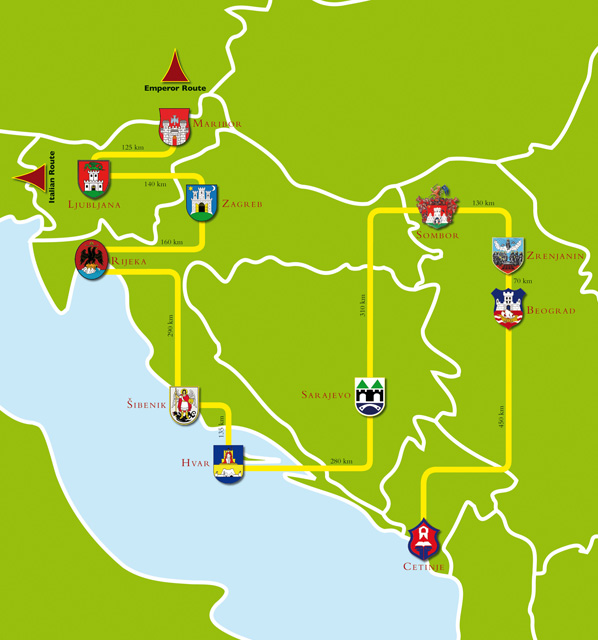
The first stop is Maribor in Slovenia. The Slovenian National Theatre was built in 1852 in classicistic style, while its auditorium is neobaroque. In Ljubljana, there are two important theatres: the Opera House, an impressive building from 1892, designed by the architects Hrasky&Hruby, and the Slovene Drama Theatre, a secessionist building by Aleksandar Graf (1911), which originally was the theatre of the German speaking citizens.
From Ljubljana we proceed to the capital of Croatia, Zagreb, and its biggest theatre, the Croatian National Theatre, inaugurated in 1895. This neobaroque building was designed by the famous Viennese architects Fellner and Helmer. The theatre owns eight painted curtains of exceptional beauty. Ten years earlier, the same architects had designed the beautiful National Theatre „Ivan pl. Zajc“ in Rijeka that today offers productions in Italian, too. Its ceiling is decorated with six allegories, four by Klimt brothers. Still earlier, 1863-1870, Josip Slade Šilović from Trogir built the eclectic city theatre in Šibenik.
On the island of Hvar, we discover the oldest communal theatre in Europe. It was installed in 1612 in a preexisting building, the Arsenal. The present auditorium was designed by Crescini in 1803.
Leaving the Adriatic coast, we drive into Bosnia & Herzegovina. The most important theatre in the country is the National Theatre in Sarajevo, built to designs by Karlo Paržik in 1921.
Going up North through Serbia, we visit the theatre in Sombor, featuring the historistic style of 1882. The oldest theatre in Serbia opened in 1839 in Zrenjanin and is named after the great Serbian actor Toša Jovanović. The biggest theatre in the region can be found in Belgrade. Built in 1868 and redesigned in 1922 by Josip Bukavac, it offers opera, drama and ballet.
The Adriatic Route ends in Montenegro. The Royal Theatre «Zetski dom» in Cetinje rose in 1884–1892 as a culture centre, designed by the architect of the Šibenik theatre (above); today it is one of just two State Theatres in the country.
With the support of the Culture Programme of the European Union

 Deutsch
Deutsch English
English Français
Français
